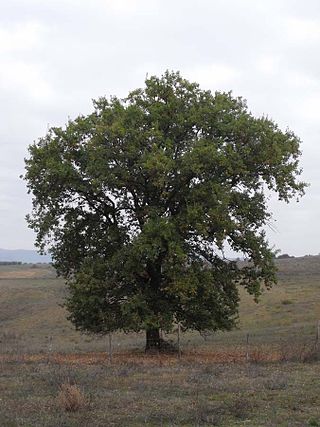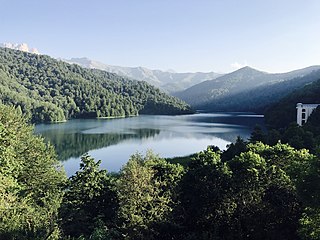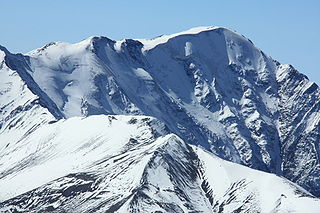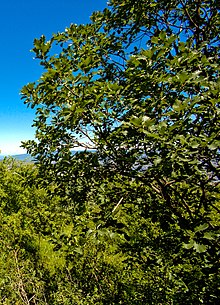
The mouflon is a wild sheep native to Cyprus, and the Caspian region, including eastern Turkey, Armenia, Azerbaijan, Georgia and Iran. It is also found in parts of Europe. It is thought to be the ancestor of all modern domestic sheep breeds.

Quercus suber, commonly called the cork oak, is a medium-sized, evergreen oak tree in the section Quercus sect. Cerris. It is the primary source of cork for wine bottle stoppers and other uses, such as cork flooring and as the cores of cricket balls. It is native to southwest Europe and northwest Africa. In the Mediterranean basin the tree is an ancient species with fossil remnants dating back to the Tertiary period. It can survive for as long as two centuries. Typically, once it reaches 25 years old, its thick bark can be harvested for cork every 9 to 12 years without causing harm to the tree.

Quercus petraea, commonly known as the sessile oak, Cornish oak, Irish oak or durmast oak, is a species of oak tree native to most of Europe and into Anatolia and Iran. The sessile oak is the national tree of Ireland, and an unofficial emblem in Wales and Cornwall.

Quercus pubescens, commonly known as the downy oak, pubescent oak or Italian oak, is a species of white oak native to southern Europe and southwest Asia. It is found from northern Spain (Pyrenees) and France in the West to Turkey and the Caucasus in the East.

Quercus pontica, the Pontine oak or Armenian oak, is a species of endangered oak currently extant to the western Caucasus mountains of Georgia and northeastern Turkey where it grows at altitudes of 1,300–2,100 metres.

The Zagros Mountains forest steppe is a temperate broadleaf and mixed forests ecoregion in Western Asia. The ecoregion extends along the Zagros Mountains, stretching from eastern Turkey and northern Iraq to southern Iran.

Quercus faginea, the Portuguese oak, is a species of oak native to the western Mediterranean region in the Iberian Peninsula. Similar trees in the Atlas Mountains of northwest Africa are usually included in this species, or sometimes treated as a distinct species, Quercus tlemcenensis. It occurs in mountains from sea level to 1,900 metres above sea level, and flourishes in a variety of soils and climates. Out of all the oak forests in the Iberian Peninsula, the southern populations of Portuguese oak were found to have the highest diversity and endemism of spider species.

Hirkan National Park is a national park in Azerbaijan, in the Talysh region. It was established in an area in Lankaran Rayon and Astara Rayon administrative districts on February 9, 2004 on the basis of the former "Hirkan State Reserve" which it superseded, on a surface area of 29,760 hectares (297.6 km2). It was enlarged by presidential decree on April 23, 2008 from 29,760 hectares (297.6 km2) to 40,358 hectares (403.58 km2).

Göygöl National Park — is a national park of Azerbaijan. It was established in an area in Goygol Rayon administrative district on April 1, 2008, on the basis of the former "Goy Gol State Reserve" that was established in 1925 and which it superseded, on a surface area of 12,755 hectares (127.55 km2). It was enlarged from 6,739 hectares (67.39 km2) of the former state reserve to its current surface area as a national park. The park is the most visited in the country.

Shahdag National Park — is a national park of Azerbaijan. It was established on an area of 115,900 hectares (1,159 km2) in the Quba Rayon, Qusar Rayon, İsmayıllı Rayon, Qəbələ Rayon, Oğuz Rayon and Şamaxı Rayon administrative districts on December 8, 2006. It was enlarged by presidential decree on July 8, 2010 from 115,900 hectares (1,159 km2) to 130,508.1 hectares (1,305.081 km2).

The European cat snake, also known as the Mediterranean cat snake, is a non venomous colubrid snake endemic to the Mediterranean and Caucasus regions.

The Hyrcanian forests are a zone of lush lowland and montane forests covering about 55,000 square kilometres (21,000 sq mi) near the shores of the Caspian Sea in Iran and Azerbaijan. The forest is named after the ancient region of Hyrcania. The World Wide Fund for Nature refers to the ecoregion as the Caspian Hyrcanian mixed forests. Since 5 July 2019, the Hyrcanian Forests have been designated a UNESCO World Heritage Site. In September 2023, the heritage site expanded to incorporate portions of the forest located in Azerbaijan.

Quercus ithaburensis, the Mount Tabor oak, is a tree in the beech family Fagaceae. It is found from southeastern Italy to the Levant. It is the national tree of Jordan. Two subspecies are accepted, Quercus ithaburensis subsp. ithaburensis and Quercus ithaburensis subsp. macrolepis. Together with Quercus brantii, it forms a clade of distinct, closely related species within the oak section Cerris.

Quercus petraea subsp. polycarpa, synonyms including Quercus iberica, is a deciduous tree native from Austria to Iran. Its range includes the Caucasus, where it may be called the Georgian oak.

Quercus lanata, the woolly-leaved oak, is a species of Quercus native to southern and southeastern Asia, including India, Bhutan, Nepal, Indochina, and southwestern China. It is a large evergreen tree up to 30 metres tall. The leaves are thick and leathery, green on top but covered in thick wool on the underside. It is classified in subgenus Cerris, section Ilex.
Asphodeline tenuior, the thin asphodeline, is a species of plant in the family Asphodelaceae, subfamily Asphodeloideae. It is native to the Caucasus, as well as from eastern Turkey and northwestern Iran. Within Russia, it is known from eastern Krasnodar Krai, Karachay-Cherkessia, Stavropol Krai and western Kabardino-Balkaria. It can be found on stony slopes and scree on limestone and sandstone, from elevations of 500–1,000 m. It is threatened by habitat loss and degradation, due to lime pits, slope terracing and cattle pasturing.
- Asphodeline tenuior var. puberulentaTuzlaci - eastern Turkey
- Asphodeline tenuior subsp. tenuiflora(K.Koch) Tuzlaci - Turkey, Iran, south Caucasus
- Asphodeline tenuior subsp. tenuior - north and south Caucasus

Acer hyrcanum is a maple species sometimes referred to as Balkan maple. It grows in southeastern Europe and western Asia.

The total forest area of Azerbaijan is 1,021,880 ha or 11.8% of the country's area. The forest biomes consist of temperate deciduous forests, temperate broadleaf and mixed forests, temperate coniferous forests and riparian forests. Specialists estimate that in the 8th-9th centuries the forest cover was around 30-35%, most of it situated in mountainous areas.

Ophrys sphegodes subsp. taurica, with many synonyms, including Ophrys caucasica, is a subspecies of orchid native from southeast Europe through the Caucasus to Iran. As Ophrys caucasica, it has been recorded in numerous areas throughout Armenia, Azerbaijan, Georgia and Russia. Local names include Armenian: Սարդակիր Մեղվակիր, romanized: Sardakir mexvakir, [xarı-bülbül] Error: {{Langx}}: transliteration of latn script (help) and Georgian: ფუტკრის-დედა, romanized:put'k'ris-deda.
Quercus look, the look oak or Mount Hermon oak, is a species of oak in subgenus Cerris, section Cerris, native to the Levant region of Western Asia, including northern Israel, Lebanon, and Syria. Of the local oak species, it prefers to grow at the highest altitudes, for instance at c. 1800 m on Mount Hermon.



















